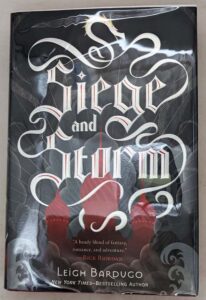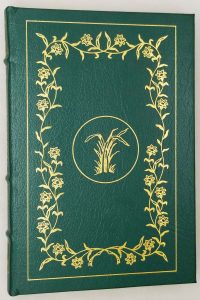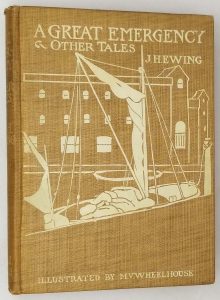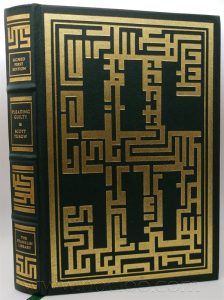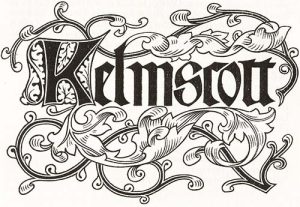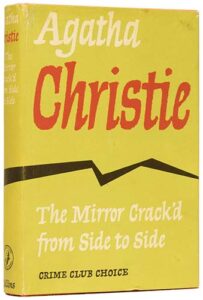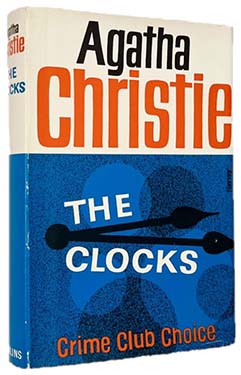
The Clocks is a work of detective fiction by British writer Agatha Christie, first published in the UK by the Collins Crime Club on 7 November 1963 and in the US by Dodd, Mead and Company the following year. It features the Belgian detective Hercule Poirot. The UK edition retailed at sixteen shillings (16/-) and the US edition at $4.50.
In the novel Poirot never visits any of the crime scenes or speaks to any of the witnesses or suspects. He is challenged to prove his claim that a crime can be solved by the exercise of the intellect alone. The novel marks the return of partial first-person narrative, a technique that Christie had largely abandoned earlier in the Poirot sequence but which she had employed in the previous Ariadne Oliver novel, The Pale Horse (1961). There are two interwoven plots: the mystery Poirot works on from his armchair while the police work on the spot, and a Cold War spy story told in the first person narrative.
References to other works
- In Chapter 14, Poirot refers again to one of his favourite cases, the one related in The Nemean Lion, the first story of The Labours of Hercules.
- In Chapter 24 mention is made of Poirot’s role in “the Girl Guide murder case”. This had been retold in Dead Man’s Folly.
- In Chapter 25, Lamb meets a little girl with her broken leg in a cast who spends the day looking out of the window at the neighbours, whom she has given fanciful descriptive names. The inspiration for this plot device is possibly Alfred Hitchcock’s 1954 film, Rear Window, a nod to a classic. In the same chapter, the little girl refers to a neighbour called Miss Bulstrode, though it seems unlikely that the character is the same Miss Bulstrode from Cat Among the Pigeons.
Plot Summary
[SPOILER ALERT]
Sheila Webb, a typist at Miss Martindale’s agency, arrives at her afternoon appointment at Wilbraham Crescent in Crowdean, Sussex. She finds a well-dressed older man, stabbed to death, surrounded by six clocks, four of which are stopped at 4:13, while the cuckoo clock announces it is 3 o’clock. When a blind woman enters the house about to step on the corpse, Sheila runs screaming out of the house and into the arms of a young man passing down the street.
This man, Special Branch or MI5 agent Colin “Lamb”, takes Sheila into his care. He is investigating a clue from a note found in a dead agent’s pocket; letter M, number 61, and a sketch of a crescent moon written on a bit of hotel stationery (sketched in the book). At 19 Wilbraham Crescent, home of the blind Miss Pebmarsh, a police investigation begins into the murder. The dead man’s business card proves false. His clothing reveals nothing else, as all labels have been removed. He was killed with an ordinary kitchen knife. Colin and Inspector Hardcastle interview the neighbours. Their homes adjoin the murder site on the street or from the back gardens in this unusually arranged Victorian housing development. Colin takes a liking to Sheila.
Hardcastle questions Mrs Lawton, the aunt who raised Rosemary Sheila Webb. Rosemary is the name on a clock found at the scene of the murder, but it disappeared before police gathered them up. Colin approaches Hercule Poirot, an old friend of his father, to investigate the case. He challenges Poirot to do so from his armchair. He gives Poirot detailed notes. Poirot accepts, then instructs Colin to talk further with the neighbours.
At the inquest, the medical examiner explains that chloral hydrate was given to the victim before he was murdered. After the inquest, Edna Brent, one of the secretaries, expresses confusion at something said in evidence. She tries but fails to convey this to Hardcastle. She is soon found dead in a telephone box on Wilbraham Crescent, strangled with her own scarf. The dead man’s identity is as yet unknown. Mrs Merlina Rival (original name Flossie Gapp) identifies the dead man as her one-time husband, Harry Castleton. Colin leaves Britain on his own case, travelling behind the Iron Curtain to Romania. He returns with the information he needed, but not the person he hoped to find. Following Poirot’s advice, Colin talks with the neighbours. He finds a ten-year-old girl, Geraldine Brown, in the apartment block across the street. She has been observing and recording the events at Wilbraham Crescent while confined to her room with a broken leg. She reveals that a new laundry service delivered a heavy basket of laundry on the morning of the murder. Colin tells Hardcastle.
Hardcastle tells Mrs Rival that her description of the deceased is not accurate. Upset, she calls the person who involved her in this case. Despite police watching her, she is found dead at Victoria tube station, stabbed in the back. Poirot’s initial view of this case is that the appearance of complexity must conceal quite a simple murder. The clocks are a red herring, as is the presence of Sheila, and the removal of the dead man’s wallet and tailor marks in the clothing. Colin updates Poirot on subsequent visits.
At a room in a Crowdean hotel, Poirot tells Inspector Hardcastle and Colin Lamb what he has deduced. From a careful chronology, he deduces what Edna realised. She returned early from lunch on the day of the murder because her shoe was broken, unnoticed by Miss Martindale, the owner. Miss Martindale took no telephone call at the time she claimed she had, and is the one person with motive to murder Edna. From that fictitious call, the boss sent Sheila to Miss Pebmarsh’s house for steno/typing service. Miss Pebmarsh denies requesting this service. Mrs Bland, one of the neighbours, mentioned she had a sister in the initial interview with Hardcastle. Poirot deduced the identity of this sister as Miss Martindale.
The present Mrs Bland is the second Mrs Bland. Mr Bland said his wife was the sole living relative for her family inheritance but she cannot both be sole heir and have a sister. Mr Bland’s first wife died in the Second World War; he remarried soon after, to another Canadian woman. The family of his first wife had cut off communication with their daughter so thoroughly they did not know she had died. Sixteen years later, the first wife was announced to be the heiress to an overseas fortune as the last-known living relative. When this news reached the Blands, they decided the second Mrs Bland must pose as the first Mrs Bland. They fool a British firm of solicitors that sought the heir. When Quentin Duguesclin, who knew the first wife and her family, looked her up in England, a plan was laid to murder him. The plan was simple, with additions like the clocks taken from an unpublished mystery story that Miss Martindale had read in manuscript.
They murdered Mrs Rival before she could tell the police who hired her. Mr Bland and his sister-in-law thought their plan would baffle the police, while Mrs Bland felt she was a pawn in their schemes. Mr Bland disposed of Duguesclin’s passport on a trip to Boulogne, which trip he mentioned to Colin in casual conversation. Poirot holds that people reveal much in simple conversation. Poirot had assumed this trip took place, so the man’s passport would be found in a country different from where he was murdered, and long after friends and family in Canada had missed him on his holiday in Europe. The missing clock, with Rosemary written on it, was traced. Colin realises that Sheila had taken it and tossed it in the neighbour’s dustbin, seeing it was her very own clock, mislaid on the way to a repair shop. But the clock was taken by Miss Martindale, not mislaid by Sheila.
Colin turns his note upside down, and it points him to 19 Wilbraham Crescent. Miss Millicent Pebmarsh is the centre of the ring passing information to the other side in the Cold War, using Braille to encode their messages. He has decided to marry Sheila and realises that Miss Pebmarsh is Sheila’s mother, and thus his future mother-in-law. He gives her two hours warning of the net closing around her. She chose her cause over her child once, and does so again, clutching a small deadly knife. “Lamb” disarms her and the two wait for the arrest, both firm in their convictions. The novel closes with two letters from Inspector Hardcastle to Poirot, telling him police have found all the hard evidence to close the case. Mrs Bland, less ruthless than her sister, admitted all under questioning.
Publication history
- 1963, Collins Crime Club (London), 7 November 1963, Hardcover, 256 pp
- 1964, Dodd Mead and Company (New York), Hardcover, 276 pp
- 1965, Pocket Books (New York), Paperback, 246 pp
- 1966, Fontana Books (Imprint of HarperCollins), Paperback, 221 pp
- The novel was first serialised in the UK weekly magazine Woman’s Own in six abridged instalments from 9 November – 14 December 1963 with illustrations by Herb Tauss. It was advertised as being serialised prior to the publication of the book; however this had already appeared on 7 November. In the US a condensed version of the novel appeared in the January 1964 (Volume 156, Number 1) issue of Cosmopolitan with illustrations by Al Parker.
The Clocks – First Edition Book Identification Guide
The books are listed in the order of publication. While the majority of Agatha Christie’s books were first published in the UK. There are many titles that were first published in the US. The title of the book may differs from the UK edition in some cases.
| Year | Title | Publisher | First edition/printing identification points |
|---|---|---|---|
| 1963 | The Clocks | William Collins & Sons, London, [1963] | First edition. "© Agatha Christie, Ltd., 1963" stated on the copyright page. No statement of later printings. Red cloth lettered in black. Price $ 16s. |
| 1964 | The Clocks | Dodd, Mead & Co, NY, [1963] | First American edition. Copyright 1963 stated on the copyright page. No statement of later printings. Red boards lettered in red. Published in 1964, but copyright date 1963. Price $ 4.50. |
Note about Book Club Editions (BCE) and reprints:
UK: You can see statements of later reprint dates or of book club on the copyright page.
US: The US reprint publishers usually use the same sheets as the first edition and are harder to identify by looking at the title page or the copyright page. One may identify a BCE by looking at the DJ, which doesn’t have a price on top of the front flap and a “Book Club Edition” imprint at the bottom. If the dust jacked is clipped at both the top/bottom of the front flap. You can safely assume it’s a BCE . If the book is missing the dust jacket. Later BCE editions can be identified by its plain boards, while first printings are issued in quarter cloth.
Please refer to the gallery for detailed images of true first edition bindings and dust jackets.
The Clocks – First Edition Dust Jacket Identification Guide
First edition bindings and various dust jacket printings identification.

